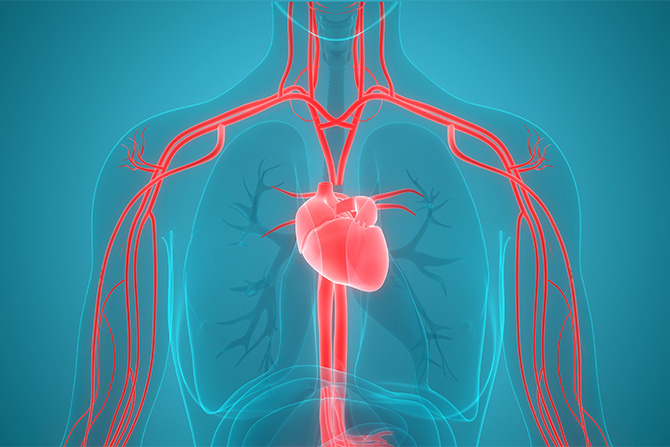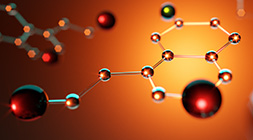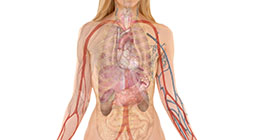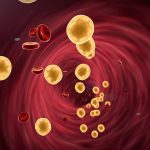
North Americans have attempted to reduce fat and cholesterol in their diets for more than 30 years, but cardiovascular disease still causes over 40 percent of all deaths.
The cardiovascular system—comprising a heart, veins, arteries, some blood vessels, and blood—sounds simple enough. But when you discover a few facts—such as that the heart never rests or that in the course of an average lifetime, it could fill 100 swimming pools full of blood and will beat over 2 billion times—simple is not the adjective that comes to mind… amazing would be more appropriate.
Transportation System of the Body
Sixty thousand miles (96,000 km) of blood vessels course through our anatomical landscape—that’s two and a half times the circumference of the Earth at the equator—and is likened to a “river of health.” The name is appropriate provided that the river can flow unhindered to bring foodstuffs to the cells (nutrients and oxygen) and haul away the trash (toxins and cellular wastes). However, if any routes along the river become jammed, the cells starve and die or mutate into abnormal or toxic cells and promote atherosclerosis (hardening of the arteries), and ultimately death.
As the transporter of our infection-fighting white blood cells, the cardiovascular system is crucial to the immune system. Without the nutrients delivered by blood, the immune system doesn’t have the components to mount an adequate defense against invaders. If the toxins and wastes are not removed, the immune system will be overworked in fighting deformed or abnormal cell growth in the body, in addition to its regular surveillance of external invaders. To have optimal immunity, the health and vitality of the cardiovascular system is paramount, with new research confirming a direct connection between immunity and cardiovascular disease.
A team of Canadian researchers discovered that an error in the regulation of certain immune cells that fight bacterial infections might be implicated in heart attacks and strokes. Josef M. Penninger, MD, Ph.D, an immunologist at the Amgen Institute and the Ontario Cancer Institute at Princess Margaret Hospital, and the department of Medical Biophysics at the University of Toronto, found that in some people the bacteria chlamydia causes the body’s immune system to target the heart, causing inflammation and arterial plaque buildup, which leads to heart disease and myocardial infarctions (MI), commonly called heart attacks.
Parts of the Cardiovascular System
The heart is roughly the size of a fist. When at rest, it pumps an average of 1.5 gal (5–6 L) of blood per minute. The heart is a hollow muscle consisting of two top chambers called the atria and two bottom chambers called the ventricles. The heart muscle is extremely active and contains a high number of mitochondria cellular powerhouses that produce ATP or energy, which keeps our heart pumping.
Five types of blood vessels transport blood between the heart and cells:
- Arteries
- Arterioles
- Capillaries
- Venules
- Veins
High cholesterol and bacterial infections can clog up and damage the blood vessel system. Keeping this system clear of debris is essential to longevity.
Arteries are large blood vessels that bring oxygen-rich blood from the ventricles. They are wide in diameter and have thick, elastic walls that are well suited to carrying blood at forceful pressures. There are two types of coronary arteries carrying blood throughout the body: the pulmonary circuit, which carries blood from the heart to the lungs then back to the heart, and the systemic circuit, which is the network of vessels from the heart to all areas of the body.
Before arteries reach the capillaries, they subdivide into smaller, thinner vessels called arterioles, which are thinner because as they disperse throughout the body, they don’t have to accommodate the same level of pressure as the arteries. Their declining size works as a medium for linking the arteries to the capillaries.
The capillaries are the smallest vessels in the body. They connect arterioles to the venules. Capillaries have very thin walls that transfer nutrients and oxygen to the blood and tissues, and also remove carbon dioxide. Because different tissues require varying amounts of nutrients and oxygen, the number of capillaries they have varies accordingly. Muscle needs plenty of oxygen, so its capillary network is immense. The cornea and the skin do not require as much oxygen, so they have a smaller capillary network.
The venules are the tiny vessels that act as the medium between the capillaries and the veins. Veins are larger vessels that run alongside arteries, bringing oxygen-poor blood back to the heart. In contrast to the arteries, the venous walls are not under as much pressure in their circulation so they are thinner, less muscular, and less elastic.
Blood pressure is simply the force or the push against the walls of arteries as blood courses through them. Every heartbeat pumps out blood, so the pressure inside the arteries increases; as the heart relaxes between beats, the pressure drops. Two readings are required to evaluate your blood pressure. The first and larger figure is the systolic pressure—when the heart beats. The second and smaller figure is the diastolic pressure—when the heart is at rest. A normal range for systolic pressure is between 100 and 140 and between 60 and 90 for diastolic pressure.
Blood Is Thicker Than Water
Blood is composed of liquid and solid constituents. The liquid in blood is called plasma and the solids are made up of red blood cells, white blood cells, and platelets. An average adult has roughly 4–5 qts (over 4 L) of blood in his or her body. Plasma, which is 92 percent water, is a mixture of hormones, proteins, and vitamins. It holds the platelets and blood cells in suspension.
Ninety-nine percent of your blood cells are red blood cells. Their color is attributed to the protein hemoglobin, which transports oxygen to the cells of the body. A red blood cell count is the amount of red blood cells per cubic millimeter of blood. Healthy adults can have a red blood cell count of anywhere from 4 to 6 million cells.
White blood cells are created in bone marrow and are the warriors of your immune system. They eat bacteria and can produce the antibodies that destroy infectious invaders. The cells transport immune cells via the blood to the infected area. A white blood cell count for a healthy adult is only 4000 to 10,000 cells per cubic millimeter of blood. This is the cell count that doctors monitor for signs of illness. (See The Immune System.)
Platelets are cell fragments that are less than half the size of red blood cells. They repair vessels by sticking to damaged walls and causing the blood to clot (coagulation) to prevent the blood from escaping the blood vessel, but this can also be a safety mechanism that turns disastrous when excessive stickiness occurs and promotes heart disease and stroke.













